This year, the Creative Time Summit takes place in Stockholm, Sweden. We’re living blogging it (with time delays). Watch the livestream here.
19:00 Anne Pasternak’s opening remarks Speaking from inside of what looks like a pixellated stack of michelin tubes and in front of an enormous candy cane.
20:16 Whitney: Pasternak explains the purpose and mission of Creative Time: “What we’re really about is to help artists engage with the debates and dialogues and big ideas of our time. And whether we do this by presenting a giant…sixty-foot-tall sphinx made of sugar in a former factory in Brooklyn, or skywriting over New York City, or projecting films on city skyscrapers, or even sending an artwork into the geosynchronous orbit circling the earth, there’s always something in common with our work: …that is that we believe passionately that public spaces are places for free and creative expression, that artists should be experimenting, and that artists are not peripheral to our daily lives.” Eyeroll.
Readers can probably prepare to hear lots of complaining from us about the concept the “big ideas” deserve big expensive splashy statement-making. This summit, we’ll be hearing about “big issues” poor people grapple with: “mass exodus, refugee status and the mass migrations and immigrations across the world and the very difficult challenges that all of our nations are really struggling with today as a result.”
Again, we will meet these “big issues” by sending art into the geosynchronous orbit.
Paddy: She sounds like someone who spends all of her time fundraising. Because poor people really benefited when Trevor Paglen shot his photos into outer space.
Corinna: Yeah, but I’m not going to gauge the quality of the rest of the summit on a fundraising pitch; it does seem, though, like Creative Time has become two separate entities. There’s the Summit, that deals with the nitty-gritty of political issues, then the spectacular art projects to the moon.
Paddy: Agreed on all that. Organizations have to balance their public programs with fundraising, and when they come together in times like this they often seem icky. (Not that anyone asked, but I think Creative Capital does a better job with managing the relationship between these two parts of their business.)
UPDATE:
26:00
Whitney: Additional intro and thanks from Magdalena Malm, the director of Sweden’s Public Art Agency, which is hosting Creative Time.
Speaking from behind a podium made of giant yellow pipe cleaners
Malm explains the Public Art Agency’s mission statement, which is basically the same.
31:27
Whitney:
This sounds like a Ted Talk.
Malm: “When we step out of the gallery spaces or the institutional spaces on the street, I think many artists do it because they want to find another audience…and to touch people in a different way. I also feel that there is this strong interest of what is going on in society, so when you step out in the street, you also engage in the issues of society.”
We’re still distracted by whatever Anne Pasternak is standing behind. Discussion in the office.
Paddy: Who is the person who makes decisions about this? This is just perfect for Anne, I think it really speaks to…
Corinna: I can’t tell if Anne is about to be squeezed to death by a pixellated cobra or if she just went tubing down Lake Mälaren.
Paddy: And then Malm looks like she’s in a prison…
Whitney: If you zoom in on Malm, it’s literally pipe cleaners…
Paddy: So she’s standing in art…
30:50
Malm: “A state is, by definition, vulnerable because it depends on other states…It is good that we have this vulnerability, it means that we are not sovereign in our own rights. It means it’s the prerequisite for a dialogue.
It’s the same with human beings. We are vulnerable. We are independent from other people…we are not universes in our own. Artists have an incredible way of reminding us in a production and consumption society of this condition of human nature. In my mind, this is the basis for dialogue, to remind ourselves that others are vulnerable…”
Whitney: This is a truism, I suppose.
36:00
Whitney: Nato Thompson finally addresses the props.
Thompson: “As you can see, we’re working the props here.
Speaking from behind an empty pink lipstick container-turned-gun turret, with a tire leaning against it.
This is the ‘totalitarian prop’. I’d like to thank Bella Roon[sp?] who did the set design.”
Corinna: Every speaker has been put into a container!
36:20
Whitney:
Thompson: “Ya know, art and politics can be very serious, so it’s nice to lighten it up. I feel like I’m in ‘Pee Wee Herman’s Playhouse.’”
Corinna: Or actually, it’s just a Bauhaus revival!
Can’t wait for the masks to come out!
UPDATE
36:50
Whitney :
[onscreen] Why a summit for art and politics?
Whitney: This is useful. Nato Thompson remembers what Creative Time set out to do, and how it did it.
Thompson: “Things have changed…and sometimes, I think that adage be careful what you wish for, because you just might get it certainly holds true to the field of socially-engaged art to some degree.
When we first started the summit [in 2009], there was a task at hand, and I think that task was called ‘legitimation’. Legitimation for a certain kind of artist…who kind of produced a way of making culture that was dealing with the political life, public spaces, that didn’t necessarily fit super-comfortably with the museum world or the gallery world…it was complex, sometimes very collaborative, sometimes questioning authorship, deeply invested in social change, wrestling with the complexities of political life…all of these things that us in political art land are familiar with, but at the same time was not representative of what was in museums and galleries that we saw. At the same time, in my life, I saw it everywhere in my life.
….
The summit…was to kind of a platform for this way of working, and to do that was basically to say we outnumber you.”
Whitney: Nice to hear Thompson speak to the basis for Creative Time, rather than what we’re used to hearing. The organization has grown exponentially and helped turn socially-engaged art into an institution of its own. After ballooning into what it is today (what I associate with celebrity-filled benefits and hundreds of people lining up to Instagram and leave) I think it’s important to hear the organization speak to its roots.
39:20
Whitney: He talks about leveraging power by putting famous people next to non-famous people– thank you, more realtalk.
Thompson: “The summit was basically to say we are here. And so we took famous people from the art world– because that’s how you get the art world to pay attention– [points to screen] so there, we’ve got Thomas Hirschhorn standing up there. And we take Okui Enwezor, Alfredo Jaar– phenomenal people– people who were known as important artists. And then we put them alongside anarchists, anti-authoritarians, people who don’t believe in artist authorship and gave them the same amount of time….This is manipulating social capital, and it worked.”
UPDATE
46:28
Silvana Imam
Whitney: Opens with a video of feminist Swedish rapper Silvana Imam’s face, with Swedish slam poetry[?] subtitled in Swedish. Followed by hip hop performance in balaclava and a reference to Pussy Riot; backgrounded with “SILVANA” in “Nirvana” text.
No idea what she’s saying, but I think it’s fair to guess this is the “social capital” portion of the summit. She makes a balaclava look hot.
UPDATE
59:27
Keynote by Saskia Sassen
1:02:30
Whitney: Unsurprisingly, Sassen brings a researched argument to the table. It is grim.
Sassen reminds us that the problems of racism, exclusion, and violence against immigrants are only getting worse while the wealthy get more and more privileged. Sassen calls the state of citizenship the “new architectures for memberships”– noting that elites from Rwanda, Shanghai, New York “barely need citizenship” since they can buy it. “Citizenship ironically is also devalued in that geography of privilege.” In the world of the have-nots, and even the middle-class, however, people are losing rights to multinational corporations.
Onscreen, Sassen flashes the highest rates of remittances, the money sent home by immigrants, which people often complain about as an economy-drainer. Among a list of nine countries, the US isn’t even among the top twenty countries losing remittances (the highest are India and China). Interesting, considering that [conservative] U.S. pundits complain constantly about immigrants sending money home all the time.
Whitney: Sassen’s not just reaffirming art values but bringing an actual argument. Appreciate this. It is useful.
Sassen also addresses the concept of “Authorized but not recognized”– mainly minority and blacks, 100,000 of whom were not allowed to vote in the last election. The weaponization and funding for border control has also gone way up.
“Even more disturbing…we have a set of laws that violate the constitution.”
Sassen talks about the lawless space of the high seas, where immigrants can be sent back to their home countries without receiving countries violating any laws. She compares this to airport security, which have implemented a high seas jurisdiction.
Increasingly, these violations of our constitution are also reaching the middle class; Clinton’s immigration law took away U.S. citizens’ right to sue in lower-order court on behalf of immigrant rights; 10,000 private and government security agencies gather data on us 24/7 throughout the US; millions disappear in prisons; citizens can be imprisoned for not having their documents on them.
“Lives ruined”.
We would be very foolish not to think these issues won’t reach us, too.
Whitney: There is no feel goodery here.
Sassen: It’s become extremely urgent that the explanation that the impoverishment of the middle class…
UPDATE
Whitney: We are never going to get through this at this rate. From here on, we’re splitting up the talks.
UPDATE: Corinna’s taking over for the moment.
Corinna: I’m here, readers! I’m gonna fast-forward to Jeremy Deller’s chit-chat with Nato Thompson because I can and because I like Jeremy Deller. That’s all. I’m going to skip all over the place!
It starts at the 05:54:54 mark on Livestream.
Corinna: Nato laughs about how Jeremy Deller’s not wearing any shoes. Point to note: He is wearing socks! Guess that’s somewhat sanitary?
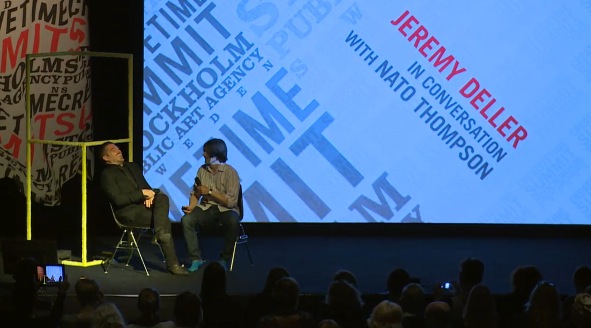 Jeremy mentions he’s going to start out the conversation by talking about failures—they’ll get to the successes at the end. He’s right: who wants to end on failure? But not too many big-name artists might even talk about their failures. Whatever—what happens in Stockholm stays in Stockholm. Okay, not really…
Jeremy mentions he’s going to start out the conversation by talking about failures—they’ll get to the successes at the end. He’s right: who wants to end on failure? But not too many big-name artists might even talk about their failures. Whatever—what happens in Stockholm stays in Stockholm. Okay, not really…
Deller says he thought it’d be a fine fit for a car on a plinth because “a car is about the same size as a man on a horse.” He kept hold of the idea, but still wanted to work more on the idea of Iraq. Nato and Deller are talking about “It Is What It Is,” Deller’s project where they drove around with a car destroyed in a Baghdad marketplace. They drove around unannounced. Being a Brit, Deller found interest in that project because he’s “still unsure of what public space is” and means in the States.
Good question, especially given that most of the U.S. is concrete. A Wal-Mart parking lot the only public space for many.
Nato: It wasn’t an art project.
Deller mentions that he thought they might get complaints from the Right, but the loudest protesters were anti-war protesters. They were upset this wasn’t overtly anti-war!
Now we’re going to watch one of Deller’s films from the CT project.
Corinna: As an journalist, I’m in awe of how Deller can strike up a conversation with just about anyone, and get them to reveal so much. Shot in Memphis, the gentleman above speaks to how, after his daughter died, a neighbor came up to him and said she died as punishment for their sin. And what was that sin? She flat out told him it was because he didn’t support George W. Bush’s war. WHAT THE FUCK WORLD DO WE LIVE IN????
Deller: “It wasn’t an activist work because it wasn’t telling you something really in those explicit ways activist works sometimes do. It’s probably a very controversial thing to say here, but…”
<—– Yes, that’s controversial to say to a group of people, many of whom believe that a point-of-view needs to be apparent in art. Ambiguity be damned!
Nato: If it were an “activist” project, it would’ve been harder to talk to people and get them to open up.
Jeremy Deller says that project is the highlight of his career. Prior to that it was his “Battle of Orgreave” work. Nato Thompson is such a fanboy! He tells Deller that “Battle of Orgreave” completely changed his idea of what public art could be!
WOW.
I personally think it’s a fantastic work; now I know that Nato thinks it’s a game-changer.
Corinna: Nato and Jeremy seem to be friends. Nato’s egging Jeremy on to talk about why he despises Downton Abbey. Nato again gives a super-super amount of praise to Deller for “Orgreaves” and the problems of making such a great work and how you follow up on that. Deller calls it his “Stairway to Heaven.”
Guys, cool it down. It’s beginning to sound like this:
You’re awesome.
No, you’re awesome.
No! You’re awesome.
Deller says he hates crowds.

Now onto Deller’s inflatable Stonehenge. He says it’s such a stupid idea even Banksy could’ve come up with it. Ba-da ching!
And just to show how many sides Deller takes with his work, Nato closes with this quite unhealthy project:
UPDATE
Corinna: I didn’t know that Creative Time had “labs.” Everyone in the audience is given yarn to play with according to some degree. Now that the audience is about to turn into a group of kittens playing with yarn, I’m outie.




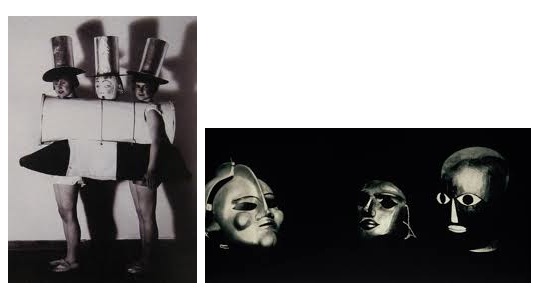
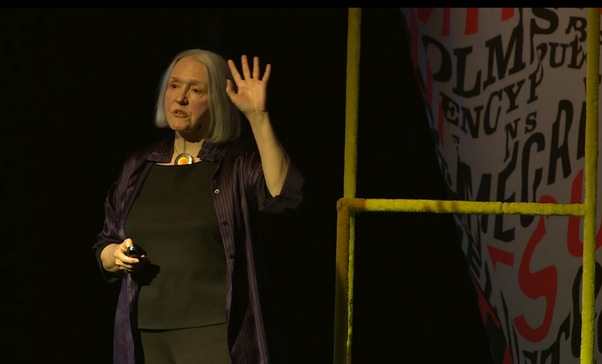

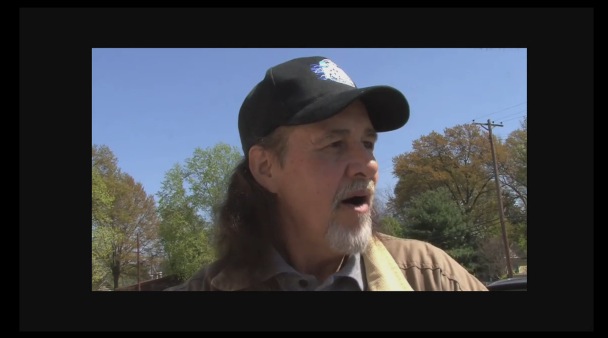
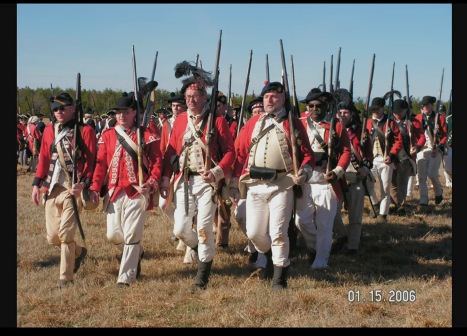


Comments on this entry are closed.